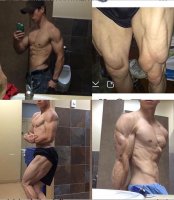on every parameter high intensity( heavier weight lower reps with longer rest between sets) is superior to high volume exercise , body fat , lean mass, power. also hormones ; cortisol ,T , igf .... everything is better!
The effect of training volume and intensity on improvements in muscular strength and size in resistance-trained men
This investigation compared the effect of high-volume (VOL) versus high-intensity (INT) resistance training on stimulating changes in muscle size and strength in resistance-trained men. Following a 2-week preparatory phase, participants were randomly assigned to either a high-volume (VOL; n = 14, 4 × 10–12 repetitions with ∼70% of one repetition maximum [1RM], 1-min rest intervals) or a high-intensity (INT; n = 15, 4 × 3–5 repetitions with ∼90% of 1RM, 3-min rest intervals) training group for 8 weeks. Pre- and posttraining assessments included lean tissue mass via dual energy x-ray absorptiometry, muscle cross-sectional area and thickness of the vastus lateralis (VL), rectus femoris (RF), pectoralis major, and triceps brachii muscles via ultrasound images, and 1RM strength in the back squat and bench press (BP) exercises. Blood samples were collected at baseline, immediately post, 30 min post, and 60 min postexercise at week 3 (WK3) and week 10 (WK10) to assess the serum testosterone, growth hormone (GH), insulin-like growth factor-1 (IGF1), cortisol, and insulin concentrations. Compared to VOL, greater improvements (P < 0.05) in lean arm mass (5.2 ± 2.9% vs. 2.2 ± 5.6%) and 1RM BP (14.8 ± 9.7% vs. 6.9 ± 9.0%) were observed for INT. Compared to INT, area under the curve analysis revealed greater (P < 0.05) GH and cortisol responses for VOL at WK3 and cortisol only at WK10. Compared to WK3, the GH and cortisol responses were attenuated (P < 0.05) for VOL at WK10, while the IGF1 response was reduced (P < 0.05) for INT. It appears that high-intensity resistance training stimulates greater improvements in some measures of strength and hypertrophy in resistance-trained men during a short-term training period
this table: PubMed Central Image Viewer.
Changes in the biochemical response to exercise following 8 weeks of training. Note. (A) Lactate; (B) testosterone; (C) cortisol; (D) insulin-like growth factor-1; (E) growth hormone; (F) insulin. Pre- (PRE; dashed) and posttraining (POST; solid) values are presented as mean ± SD. *Significant (P < 0.05) difference from baseline at week 3. #Significant (P < 0.05) difference from baseline at week 10. ‡Significant (P < 0.05) difference from week 3. †Significant (P < 0.05) difference between VOL and INT.
The effect of training volume and intensity on improvements in muscular strength and size in resistance-trained men
This investigation compared the effect of high-volume (VOL) versus high-intensity (INT) resistance training on stimulating changes in muscle size and strength in resistance-trained men. Following a 2-week preparatory phase, participants were randomly assigned to either a high-volume (VOL; n = 14, 4 × 10–12 repetitions with ∼70% of one repetition maximum [1RM], 1-min rest intervals) or a high-intensity (INT; n = 15, 4 × 3–5 repetitions with ∼90% of 1RM, 3-min rest intervals) training group for 8 weeks. Pre- and posttraining assessments included lean tissue mass via dual energy x-ray absorptiometry, muscle cross-sectional area and thickness of the vastus lateralis (VL), rectus femoris (RF), pectoralis major, and triceps brachii muscles via ultrasound images, and 1RM strength in the back squat and bench press (BP) exercises. Blood samples were collected at baseline, immediately post, 30 min post, and 60 min postexercise at week 3 (WK3) and week 10 (WK10) to assess the serum testosterone, growth hormone (GH), insulin-like growth factor-1 (IGF1), cortisol, and insulin concentrations. Compared to VOL, greater improvements (P < 0.05) in lean arm mass (5.2 ± 2.9% vs. 2.2 ± 5.6%) and 1RM BP (14.8 ± 9.7% vs. 6.9 ± 9.0%) were observed for INT. Compared to INT, area under the curve analysis revealed greater (P < 0.05) GH and cortisol responses for VOL at WK3 and cortisol only at WK10. Compared to WK3, the GH and cortisol responses were attenuated (P < 0.05) for VOL at WK10, while the IGF1 response was reduced (P < 0.05) for INT. It appears that high-intensity resistance training stimulates greater improvements in some measures of strength and hypertrophy in resistance-trained men during a short-term training period
this table: PubMed Central Image Viewer.
Changes in the biochemical response to exercise following 8 weeks of training. Note. (A) Lactate; (B) testosterone; (C) cortisol; (D) insulin-like growth factor-1; (E) growth hormone; (F) insulin. Pre- (PRE; dashed) and posttraining (POST; solid) values are presented as mean ± SD. *Significant (P < 0.05) difference from baseline at week 3. #Significant (P < 0.05) difference from baseline at week 10. ‡Significant (P < 0.05) difference from week 3. †Significant (P < 0.05) difference between VOL and INT.




